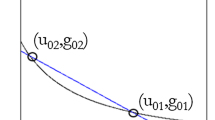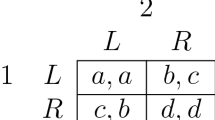Abstract
Adaptive (path dependent) processes of growth modeled by urn schemes are important for several fields of applications: biology, physics, chemistry, economics. In this paper we present a general introduction to urn schemes, together with some new results. We review the studies that have been done in the technological dynamics by means of such schemes. Also several other domains of economic dynamics are analysed by the same machinery and its new modifications allowing to tackle non-homogeneity of the phase space. We demonstrate the phenomena of multiple equilibria, different vonvergence rates for different limit patterns, locally positive and locally negative feedbacks, limit behavior associated with non-homogeneity of economic environment where producers (firms) are operating. It is also shown that the above urn processes represent a natural and convenient stochastic replicator dynamics which can be used in evolutionary games.
Similar content being viewed by others
References
Allen PM (1988) Evolution, Innovation and Economics. In: Dosi G, Freeman C, Nelson R, Silverberg G, Soete L. (eds) Technical Change and Economic Theory. Pinter Publishers, London and New York, pp 95–119
Anderson PW, Arrow KF, Pines R (eds) (1988) The Economy as an Evolving Complex System. SFI Studies in the Science of Complexity. Addison-Wesley, New York
Arthur WB, Ruszczinski A (1992) Strategic Pricing in Markets with Conformity Effects. Arch Control Sciences, 1: 7–31
Arthur WB (1983) On Competing Technologies and Historical Small Events: the Dynamics of Choice under Increasing Returns. International Institute for Applied Systems Analysis, Laxenburg, Austria WP-83-90, (Working paper)
Arthur WB (1990) “Silicon Valley” Location Clusters: When do Increasing Returns Imply Monopoly? Math Social Sci 19: 235–251
Arthur WB (1988) Self-Reinforcing Mechanisms in Economics. In: Anderson PW, Arrow KF, Pines R The Economy as an Evolving Complex System. SFI Studies in the Science of complexity. Addison-Wesley, New York, pp 9–31
Arthur WB, Ermoliev YM, Kaniovski YM (1983) The Generalized Urn Problem and Its Application. Kibernetika 1: 49–56 (in Russian)
Arthur WB, Ermoliev YM, Kaniovski YM (1987a) Adaptive Process of Growth Being Modeled by Urn Schemes. Kibernetika 6: 49–57 (in Russian)
Arthur WB, Ermoliev YM, Kaniovski YM (1987b) Nonlinear Urn Processes: Asymptotic Behavior and Applications. Interational Institute for Applied Systems Analysis, Laxenburg, Austria WP-87-85, (working paper)
Arthur WB, Ermoliev YM, Kaniovski YM (1987c) Path Dependent Processes and the Emergence of Macro-Structure. Eur J Operational Res 30: 294–303
Arthur WB, Ermoliev YM, Kaniovski YM (1988) Nonlinear adaptive Processes of Growth with General Increments: Attainable and Unattainable Components of Terminal Set. International Institute for Applied Systems Analysis, Laxenburg, Austria WP-88-86 (working paper)
Atkinson A, Stiglitz J (1969) A New View of Technological Change. Econ J 79: 573–578
Banerjee A, Weibull JW (1992) Evolution and Rationality: Some Recent Game-Theoretic Results. Presented at the Tenth World Congress of the International Economic Association, Moscow, August 1992
Boldrin M (1988) Persistent Oscillations and Chaos in Dynamic Economic Models: Notes for a Survey. In: Anderson PW, Arrow KF, Pines R (eds) The Economy as an Evolving Complex System. SFI Studies in the Science of Complexity. Addison-Wesley, New York, 49–75
Boyer R, Orléan A (1992) How do Conventions Evolve? J Evol Econ 2: 165–177
Brock WA, Malliaris AG (1989) Differential Equations, Stability and Chaos in Dynamic Economics. North Holland, Amsterdam
Cabrales A (1992) Stochastic Replicator Dynamics. Dept. of Economics, University of San Diego, California, mimeo
David PA (1985) Clio and the Economics of QWERTY. Am Econ Rev (Papers and Proceedings) 75: 332–337
David PA (1988) Path-Dependance: Putting the Past into the Future in Economics. Technical Report no. 533. Institute for Mathematical Studies in the Social Sciences, Stanford University
David PA (1975) Technical Choice, Innovation and Economic Growth. Cambridge University Press, Cambridge, Mass
Day R (1992) Irregular Growth Cycles. Am Econ Rev 72: 406–414
Dekel E, Scotchmer S (1991) On the evolution of Optimizing Behavior. J Econ Theory 59: 637–666
Dosi G (1988) Sources, Procedures and Microeconomic Effects of Innovation. J Econ Literature 26: 1120–1171
Dosi G, Freeman C, Nelson R, Silverberg G, Soete L (eds) (1988) Technical Change and Economic Theory. Francis Pinter, London and Columbia University Press, New York
Dosi G, Pavitt K, Soete L (eds) (1990) The Economics of Technological Change and International Trade. New York University Press, New York and Wheatsheaf, Brighton
Dosi G, Ermoliev Y, Kaniovski Y (1994) Generalized Urn Schemes and Technological Dynamics. J Math Econ 23: 1–19
Durlauf SN (1991) Non-Ergodic Economic Growth. Dept. of Economics, Stanford University, mimeo
Eigen M, Schuster P (1979) The Hypercycle: Principle of Natural Selforganization Springer, Berlin Heidelberg New York
Foster D, Young HP (1990) Stochastic Evolutionary Game Dynamics. Theoretical Population Biol 38: 219–232
Freeman C (1982) The Economics of Industrial Innovation, 2nd edn. Francis Pinter, London
Friedman D (1991) Evolutionary Games and Economics. Econometrica 59: 637–666
Frydman R (1982) Towards an Understanding of Market Processes: Individual Expectations, Learning and Convergence to Rational Expectations Equilibrium. Am Econ Rev 72: 652–668
Frydman R, Phelps ES (eds) (1983) Individual Forecasting and Aggregate Outcomes. Oxford University Press, Oxford
Fudenberg D, Kreps DM (1993) Learning Mixed Equilibria. Games Econ Behavior 4: 320–367
Glaziev SY, Kaniovski YM (1991) Diffusion of Innovations Under Conditions of Uncertainty: A Stochastic Approach. In: Nakicenovic N, Grubler A (eds), Diffusion of Technologies and Social Behavior Springer, Berlin Heidelberg New York pp 231–246
Hanson WA (1985) Bandwagons and Orphans: Dynamic Pricing of Competing Systems Subject to Decreasing Costs. Ph.D. Dissertation, Standard University, Stanford
Hill BM, Lane D, Sudderth W (1980) A Strong Law for Some Generalized Urn Processes. Ann Probability 8: 214–226
Jordan J (1985) Learning Rational Expectation: The Finite State Case. J Econ Theory 36: pp 257–276
Kandori M, Mailath GJ, Rob R (1993) Learning, Mutation, and Long Run Equilibria in Games. Econometrica 61: 29–56
Kaniovski Y, Pflug G (1992) Non-standard Limit Theorems for Stochastic Approximation and Their Applications for Urn Schemes. International Institute for Applied Systems Analysis, Laxenburg, Austria WP-92-25 (working paper)
Kaniovski Y, Young HP (1994) Dynamic Equilibria Selection Under Incomplete Information. International Institute for applied Systems analysis, Laxenburg, Austria WP-94-30 (working paper)
Kirman A (1991) Epidemics of Opinion and Speculative Bubbles in Financial Markets. In: Taylor M (ed) Money and Financial Markets. Macmillan, London
Kuran T (1991) Congnitive Limitations and Preference Evolution. J Institutional Theoretical Econ 147: 241–273
Ljung L, Söderström T (1983) Theory and Practice of Recursive Identification. M.I.T. Press, Cambridge, Mass
Metcalfe JS (1988) The Diffusion of Innovations: an Interpretative Survey. In: Dosi G, Freeman C, Nelson R, Silverberg G, Soete L (eds) Technical Change and Economic Theory. Francis Pinter, London and Columbia University Press, New York, pp 560–589
Nelson R, Winter S (1982) An Evolutionary Theory of Economic Change. The Belknap Press of Harward University Press, Cambridge, Mass
Nicolis G, Prigogine I (1971) Self-Organization in Nonequilibrium Systems: From Dissipative Structures to Order through Fluctuations. Wiley, New York
Nicolis G, Prigogine I (1989) Exploring Complexity. An Introduction. Freeman, New York
Pemantle R (1991) When Are Touchpoints Limits for Generalized Pólya Urns? Proc Am Math Soc 113: 235–243
Polterovich VM, Henkin GM (1988) An Economic Model of Interaction of Processes of Creation and Leasing of Technologies. Ekonomika i Matematicheskie Metody 24: 1071–1083 (in Russian)
Prigogine I, Stengers I (1984) Order out of Chaos: Man's New Dialogue with Nature. Heinemann, London
Rosser JB, Jr (1991) From Catastrophe to Chaos: A General Theory of Economic Discontinuities. Kluwer, Boston Dordrecht London
Samuelson L, Zhang J (1992) Evolutionary Stability in Asymmetric Games. J Econ Theory 57: 363–391
Silverberg G, Dosi G, Orsenigo L (1988) Innovation, Diversity and Diffusion: a Self Organization Model. Econ J 98: 1032–1054
Silverberg G (1988) Modelling Economic Dynamics and Technical Change: Mathematical Models of Self-Organisation and Evolution. In: Dosi G, Freeman C, Nelson R, Silverberg G, Soete L (eds) Technical Change and Economic Theory. Francis Pinter, London and Columbia University Press, New York, pp 531–559
Soete L, Turner R (1984) Technological Diffusion and the Rate of Technical Change. Econ J 94: 612–623
Winter S (1971) Satisficing, Selection and the Innovating Remnant. Quarterly J Econ 85: pp 237–261
Young P (1993) The Evolution of Conventions. Econometrica 61: 57–84
Author information
Authors and Affiliations
Rights and permissions
About this article
Cite this article
Dosi, G., Kaniovski, Y. On “badly behaved” dynamics. J Evol Econ 4, 93–123 (1994). https://doi.org/10.1007/BF01200140
Issue Date:
DOI: https://doi.org/10.1007/BF01200140




